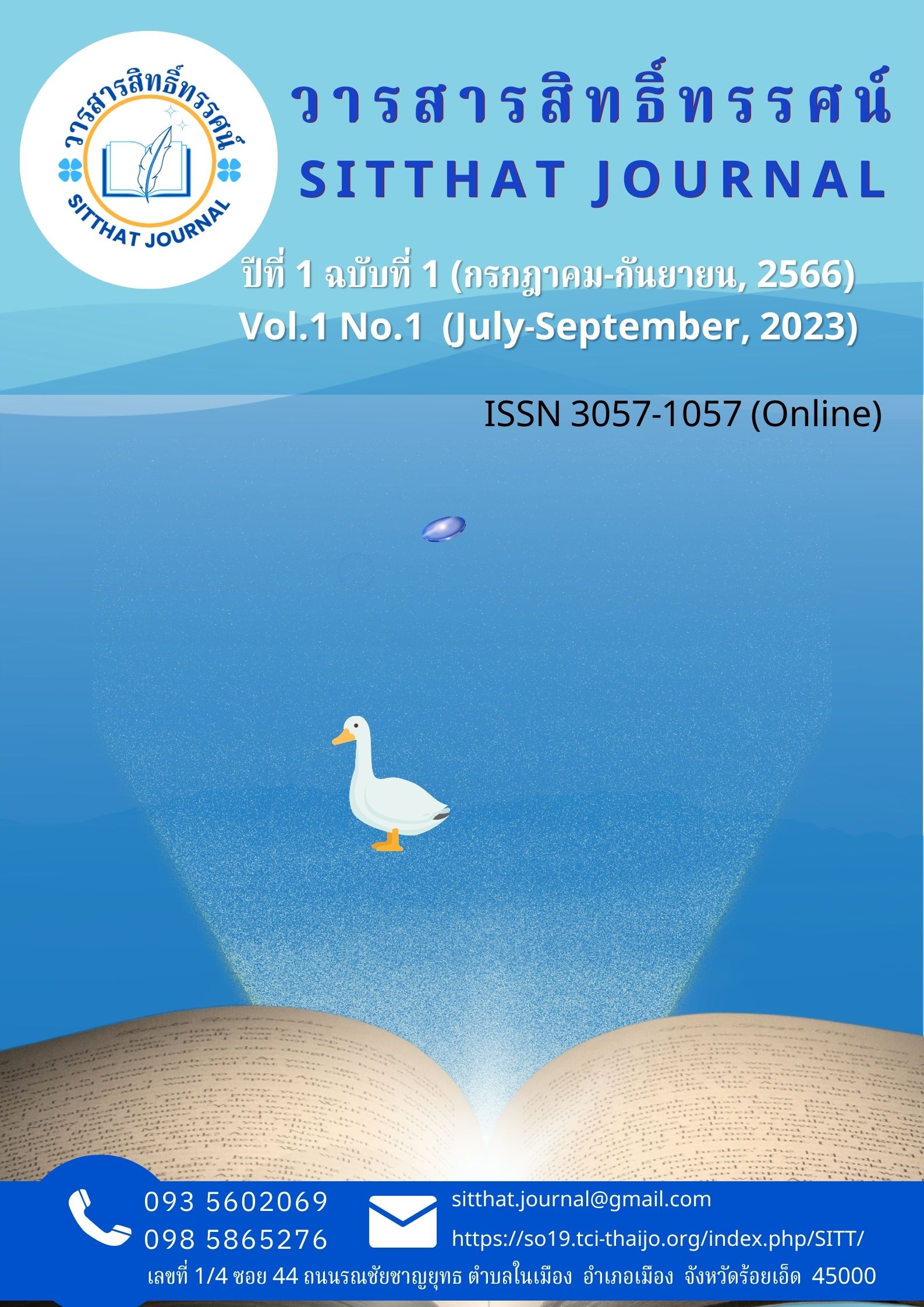CONFLICT MANAGEMENT OF COMMUNITY LEADERS IN BUENG KAN PROVINCE
Main Article Content
Abstract
This research aimed to 1) study the conflict management of community leaders in Bueng Kan Province, 2) study the factors of conflict management of community leaders in Bueng Kan Province, and 3) study the development guidelines for conflict management of community leaders in Bueng Kan Province. It was a quantitative and qualitative research. The sample group used in this research were 397 eligible voters in Bueng Kan Province. The qualitative data collection group was conducted by in-depth interviews, with 10 purposive sample groups selected. The instruments used were questionnaires and interview forms. The statistics used for data analysis included frequency distribution and percentage of respondents, presented in tables using mean and standard deviation, multiple regression analysis using the hierarchical variable selection method, and discussion of results. The descriptive data analysis was conducted by selecting and classifying data, organizing data systematically, editing data, and analyzing data. The data was then written as a report.
The research results found that 1) Conflict management of community leaders in Bueng Kan Province, in all aspects, was at a moderate level (=3.08.S.D =.39). Considered by each item as follows: Conflict consequences (=3.13.S.D =.16), Conflict causes (=3.08.S.D =.16), Conflict level (=3.05.S.D =.70), respectively. 2) Conflict management factors of community leaders in Bueng Kan Province (in all aspects), Complex benefits X2, Work structure X4, and the coefficient of predictors in raw scores (b) were .467 -.250, respectively. The coefficient of predictors in standard scores (β) were .672 -.631, respectively. 3) It is necessary to find the cause of conflict, which is a normal occurrence in living together in a community. It can solve problems in the community. If it is successful, it will make the relationship of people in the community not good By bringing the cause of the conflict to be mediated officially from the misunderstanding of people in the community There is disclosure or no distortion of information in working among communities Working without seeking personal benefits, expressing consistent opinions that lead to stable development, talking about better understanding about farming areas and reaching agreements The management of conflicts over water in agriculture in the community has improved and conflicts over farming rights have been effectively discussed and reached agreements.
Article Details

This work is licensed under a Creative Commons Attribution-NonCommercial-NoDerivatives 4.0 International License.
บทความนี้
References
กัลยา วานิชย์บัญชา. (2542). การวิเคราะห์สถิติ : สถิติเพื่อการตัดสินใจ . พิมพ์ครั้งที่ 4.
กรุงเทพมหานคร :โรงพิมพ์แห่งจุฬาลงกรณ์วิทยาลัย
ชไมพร เทือกสุบรรณ. (2553). ประสิทธิผลของการนำนโยบายการบริหารกิจการบ้านเมืองที่ดีไปปฏิบัติ
ในกรมที่ดิน : กรณีการนำตัวชี้วัดการพัฒนาคุณภาพการบริหารจัดการภาครัฐ (PMQA) มา
ปฏิบัติ. ใน รัฐศาสตรมหาบัณฑิต สาขาบริหารจัดการสาธารณะ .มหาวิทยาลัยธรรมศาสตร์.
ชัยยุทธ์ เหลืองบุศราคัม. (2552). ความพึงพอใจต่อการดำเนินงานพัฒนาคุณภาพการบริหารจัดการ
ภาครัฐของบุคลากร สำนักงานกรมปศุสัตว์ จังหวัดนครนายก. นครนายก:สำนักงานปศุสัตว์
จังหวัดนครนายก.
สิทธิชัย สุวรรณประทีป.(2550). คู่มือการทำกิจกรรมกลุ่มสร้างคุณภาพงาน. กรุงเทพมหานคร: โรงพิมพ์
เจริญผล.
สมศักดิ์ จังตระกล. (2554). การจัดการความขัดแย้งโดยนายอำเภอของประชาชนในประเทศไทย.
สาขาวิชาการจัดการภาครัฐและเอกชน บัณฑิตวิทยาลัย มหาวิทยาลัยคริสเตียน.Suranaree
J. Soc. Sci. Vol. 5 No. 2; December 2011 (131-148).
สุวิมล ติรกานันท์. (2550). ระเบียบวิธีวิจัยทางสังคมศาสตร์: แนวทางปฏิบัติ. กรุงเทพมหานคร: โรง
พิมพ์แห่งจุฬาลงกรณ์มหาวิทยาลัย.
สร้อยตระกูล (ติวยานนท์)อรรถมานะ. (2550). พฤติกรรมองค์การ ทฤษฎีและการประยุกต์. พิมพ์ครั้งที่
กรุงเทพมหานคร: สำนักพิมพ์มหาวิทยาลัยธรรมศาสตร์.
สนธยา พลศรี. (2547). ทฤษฎีและหลักการพัฒนาชุมชน (พิมพ์ครั้งที่5). กรุงเทพมหาคร: โอเดียนสโตร์.
สำนักบริหารทะเบียน กรมการปกครอง กระทรวงมหาดไทย รวบรวมโดย: สำนักสถิติพยากรณ์
สำนักงานสถิติแห่งชาติ ข้อมูล ณ วันที่ 15 สิงหาคม พ.ศ. 2563.
Taro Yamane. (1973 ).Statistics: An Introductory Analysis.3rdEd.New York.Harper and
RowPublications.


